Tea flavouring is crucial in tea production, allowing many flavours to hit the market.
This technique not only enhances tea’s natural flavours but also enables producers and artisans to offer a broad and diverse palette of varieties, catering to consumer tastes and preferences.
In a market where innovation and differentiation are key, tea flavouring stands out as an essential tool for complementing and elevating the inherent flavours of tea, creating unique and memorable sensory experiences.
From the classic Earl Grey, flavoured with bergamot oil, to the refreshing jasmine tea infused with jasmine flowers, the possibilities of tea flavouring are endless.
In this post, we’ll delve into the different and intriguing methods of tea flavouring, the various flavours commonly found on the market, and their profound impact on the tasting experience of this exquisite beverage.
Why Aromatise Tea?

Flavouring tea offers numerous benefits for both producers and consumers.
For consumers, flavoured teas provide a more diverse and exciting tasting experience, with a wide range to explore and enjoy.
From fruity and floral flavours to spicy and earthy ones, tea flavouring transforms each cup into a unique and thrilling adventure.
Methods of Tea Flavouring
There are various methods to infuse and provide different flavours to tea, each with its techniques and benefits.
From natural aroma absorption to the addition of essential oils and aromatic granules, these procedures create a wide range of tasting experiences.
1. Blends for Natural Aroma Absorption
This method of flavouring is one of the most common ways to impart flavour to tea. It involves creating blends by directly adding aromatic ingredients to the tea leaves.
These ingredients can include flowers, which are carefully mixed with the tea to absorb their natural aroma before being removed.
A common example is jasmine tea, made by mixing tea with fresh jasmine buds during the tea drying process. During this stage, the tea leaves naturally absorb the floral aromas of the jasmine.

2. Addition of Essential Oils
Another common practice is creating flavoured teas by adding essential oils to the base tea: a method specifically used when seeking intensity and purity of flavour.
Aromatic oils are obtained through distillation or cold pressing of natural ingredients, such as fruits, spices, and herbs.
This oil is added in small quantities during the tea production and blending process to impart its characteristic flavour. The resulting combination showcases its flavour primarily through the intensity of its aroma and taste, with minimal or no changes to the appearance of the flavoured tea.
However, adding essential oils requires a careful balance to avoid overpowering the tea with strong or artificial flavours. It’s crucial to dose precisely and select high-quality oils to ensure an optimal final result. An example is Earl Grey tea, which is flavoured with bergamot essential oil during tea production, giving it a citrusy and floral flavour.

3. Extracts and Other Aromatics
Flavouring tea through extracts involves adding concentrated aromatic ingredients, such as vanilla, fruit, or herb extracts, directly to the tea leaves. These extracts can be liquid or powdered.
Extracts are obtained by extracting the aromatic compounds from the used plants through extraction methods such as distillation, or other specific biotechnological processes.
These extracts must be derived from the mentioned plant to be considered natural aromas. However, obtaining extracts can vary depending on the plant and may involve more complex processes, such as using specialised enzymes.
Integrating extracts and other aromatics offers a wide range of possibilities to create an almost unlimited variety of flavoured teas.

Types of Flavours in Teas
As previously mentioned, tea flavouring allows for a wide range of tastes, blending the unique properties of tea with countless aromatic ingredients, and creating unparalleled taste experiences.
Here, we explore some of the most common flavours used to aromatise teas, examining their diversity and highlighting the characteristics that make them popular.
Fruity flavour
Teas flavoured with fruity notes offer a wide range of tastes, from sweet and juicy to citrusy and refreshing. These can include fresh fruits like strawberries, mangoes, and pineapples, as well as citrus fruits like lemon, orange, and grapefruit.
Floral flavour
Teas with floral flavours offer delicate floral notes that perfectly complement the tea’s smooth taste. These can include flowers like jasmine, rose, lotus, and chrysanthemum, adding a distinctive aroma and subtle sweetness to the tea.
Spicy flavour
Teas with spicy flavours offer a unique blend of warm and earthy tastes, perfect for the colder months. These can include spices like cinnamon, clove, ginger, and nutmeg, adding a touch of warmth and depth to the tea.
Conclusion
Tea flavouring not only involves the addition of flavours but also mastering precise techniques to enhance and complement the tea’s natural characteristics. It’s a practice that has transcended cultures and borders, offering a large diversity of flavours that enhance the tea-drinking experience.
From traditional methods of natural aroma absorption to the incorporation of extracts and other aromatics, each technique represents a crucial balance between craftsmanship and innovation.
Tea flavouring is carried out during the production or blending process, where tea leaves are combined with various ingredients to create unique and distinctive flavours. At Alveus, we not only create custom tea blends but also specialise in flavouring our products. This approach allows us to offer a unique and personalised tea experience, ensuring each cup is a legacy of exceptional quality and creativity.
The rich savours of flavoured teas not only respond to consumer demand for unique taste experiences but also reflect the commitment of producers and artisans to offer products of exceptional quality.
In summary, tea flavouring is a constantly evolving blending process that continues to surprise and captivate tea lovers worldwide, reaffirming its position as one of the most versatile beverages in culinary history.










